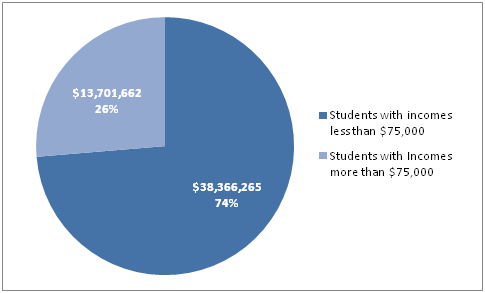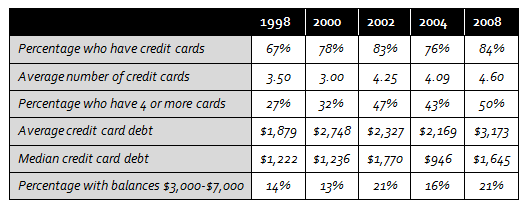 Low-income state residents are not the only ones whose dreams of higher education are thwarted by rising tuition. While schools have at least attempted to off-set some of the rising costs for low-income students, middle-income students and their families, particularly those who fall just above the cutoffs for most benefits, end up being hit hard. According to Patrick Callan, an expert on higher education financing and President of the National Center for Public Policy and Higher Education, “there is no example of this [high-tuition/high-aid] model that doesn’t squeeze the middle very hard.”
Low-income state residents are not the only ones whose dreams of higher education are thwarted by rising tuition. While schools have at least attempted to off-set some of the rising costs for low-income students, middle-income students and their families, particularly those who fall just above the cutoffs for most benefits, end up being hit hard. According to Patrick Callan, an expert on higher education financing and President of the National Center for Public Policy and Higher Education, “there is no example of this [high-tuition/high-aid] model that doesn’t squeeze the middle very hard.”
Lawmakers in Ohio are taking a closer look at tuition hikes at Indiana University and Purdue University for that very reason, asking:
…boards of trustees at the schools to meet again soon and lower — or even eliminate — the tuition increases they recently approved for the next two years. (More: Indy Star)
Lost in the rhetoric of high financial aid packages is the reality that the majority of “aid” in those packages, especially for middle-income students, comes from loans. In 1991-92, loans made up 36% of total aid packages, while grants were 61%. By 2007-08, however, loans had grown to comprise 49% of the packages, while grants fell to 45%.
As colleges increasingly rely on students to finance their own educations, and tuition rates continue to rise significantly faster than family incomes, students and their families are forced to go into debt to pay for school. Moreover, federally subsidized loans covered over half the value of all student loans in 1997-98, but only about one third in 2007-08 – meaning that for the majority of students today, interest accumulates even before they graduate.
The newly created White House Middle Class Task Force recently released a report on the issue of college affordability for the middle class. The main focus of the report was student debt. The report asserts: “The ability to afford a college education without being buried by debt is an important aspiration and a legitimate expectation, not just for middle-class families, but for any family in America.”
Unfortunately, such expectations are moving further out of reach for more and more families, as both the amount of debt and the number of students in debt continues to increase. In a national study, The Project on Student Debt calculated that in 2004, roughly two-thirds of students from four-year colleges graduated with debt, up from less than half 10 years prior.
The national average for graduating student debt in public four year universities skyrocketed during the 1990s and has continued to rise at a more moderate pace since. According to a U.S. Department of Education longitudinal study, the average amount borrowed in constant dollars by recipients of bachelor’s degrees at four-year public colleges who took out student loans shot up by 63% between 1993 and 2000. Between 2001 and 2007, the average loan total rose by an additional 8%, to $18,800. Among graduates from community and technical colleges, the most recent study from the National Center for Education Statistics estimated that average debt increased from $5,200 to $7,400 (adjusted for inflation) between 1996 and 2003, an increase of 43%.
In 2008, the average student loan debt among borrowers at the University of Washington was $16,481. This number is set to grow as the UW raises tuition in the next few years. The experience of schools already operating under the high-tuition/high-aid model warns of the significantly higher rates of student debt that likely will be in store for Washington graduates should the state continue down this path.
Percentage of Incoming University of Washington Freshman Applying for Aid with Incomes over $100,000
constant 2007 dollars

Source: Sallie Mae: How Undergraduate Students Use Credit Cards (2009)
The University of Vermont (UVM), the first school to implement the high-tuition/high-aid model, has yet to figure out how to provide enough grant benefits to students to push debt rates lower. According to Scott Giles, UVM’s Vice President of Policy, Research, and Planning, “The challenge we face is that the resources that legislature have provided us have not been sufficient, particularly over the course of the last 10 years.”
The problem of student debt has consequences that extend to the rest of society. The typical borrowing student who graduated from UW this year can expect to pay $200 per month for the next 10 years (assuming the fixed 6.8% interest rate on Federal Stafford Loans). Her peer from UM, Miami U, or the UVM will take on payments of $300 per month. These debt payments erect real barriers to purchasing a home or car or pursuing graduate education. And they portend a life of indebtedness, as home mortgages, child care, and heath care costs deepen the financial hole begun with college debt.
Moreover, students graduating with debt become chained to their payments in a way that discourages them from going into fields that are necessary for the welfare of our society but have relatively low compensation. A study by the State PIRG’s Higher Education Project showed that between one quarter and half of students from four-year schools would be unable to manage their debt if they took starting jobs as teachers or social workers.
Many students who enter low-paying fields of service have been able to do so in the past through loan debt forgiveness programs. The recent economic crisis has proven, however, that students cannot count on these programs. The Kentucky Higher Education Student Loan Corporation cut its payouts to recipients midstream, leaving teachers who had accumulated immense debt loads stranded. Similar programs supporting entry into public service professions have been suspended in other states, including in New Hampshire, Pennsylvania, Iowa, and California.
Furthermore, student loan debt is not distributed equally. In 2007-08 at the University of Washington, students from families with incomes of less than $75,000 per year carried roughly three quarters of the total student debt. Graduates with lower family incomes tend to leave with more debt than those with higher family incomes.
Share of Student Debt Upon Graduation by Family Income
2007-2008

Source: University of Washington Office of Institutional Research
Average Student Loan Debt of Graduating University of Washington Students by Income Quartiles
2007-2008

Source: University of Washington Office of Institutional Research
Importantly, the student loan numbers discussed above do not include credit card or other kinds of debt also acquired by college students. A 2009 study by Sally Mae, one of the nation’s largest private student loan providers, highlights the fact that for college students, credit card debt is becoming an increasingly prominent problem, concluding: “In this time of credit crunch and economic downturn, college students are relying on credit cards more than ever before.”
While the Sallie Mae report attributes overuse of credit cards to lack of financial education, student credit card debt is a component of the larger issue of predatory lending pursued by financial institutions and enabled by lack of government oversight over the past two decades.
Credit Card Usage Among Undergraduate Students

Source: Sallie Mae: How Undergraduate Students Use Credit Cards (2009)
Note: This is the fourth in a five-part series based on EOI’s latest report: Losing By Degrees. View part 1 here, part 2 here, part 3 here.
More To Read
September 24, 2024
Oregon and Washington: Different Tax Codes and Very Different Ballot Fights about Taxes this November
Structural differences in Oregon and Washington’s tax codes create the backdrop for very different conversations about taxes and fairness this fall
September 10, 2024
Big Corporations Merge. Patients Pay The Bill
An old story with predictable results.
September 6, 2024
Tax Loopholes for Big Tech Are Costing Washington Families
Subsidies for big corporations in our tax code come at a cost for college students and their families
